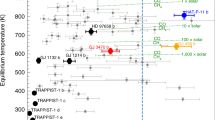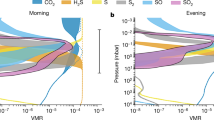Abstract
Interactions between exoplanetary atmospheres and internal properties have long been hypothesized to be drivers of the inflation mechanisms of gaseous planets and apparent atmospheric chemical disequilibrium conditions1. However, transmission spectra of exoplanets has been limited in its ability to observational confirm these theories due to the limited wavelength coverage of HST and inferences of single molecules, mostly H2O (ref. 2). In this work, we present the panchromatic transmission spectrum of the approximately 750 K, low-density, Neptune-sized exoplanet WASP-107b using a combination of HST WFC3, JWST NIRCam and MIRI. From this spectrum, we detect spectroscopic features due to H2O (21σ), CH4 (5σ), CO (7σ), CO2 (29σ), SO2 (9σ), and NH3 (6σ). The presence of these molecules enable constraints on the atmospheric metal enrichment (M/H is 10–18× Solar3), vertical mixing strength (log10Kzz = 8.4–9.0 cm2s−1), and internal temperature (>345 K). The high internal temperature is suggestive of tidally-driven inflation4 acting upon a Neptunelike internal structure, which can naturally explain the planet’s large radius and low density. These findings suggest that eccentricity driven tidal heating is a critical process governing atmospheric chemistry and interior structure inferences for a majority of the cool (<1,000K) super-Earth-to-Saturn mass exoplanet population.
This is a preview of subscription content, access via your institution
Access options
Access Nature and 54 other Nature Portfolio journals
Get Nature+, our best-value online-access subscription
$29.99 / 30 days
cancel any time
Subscribe to this journal
Receive 51 print issues and online access
$199.00 per year
only $3.90 per issue
Rent or buy this article
Prices vary by article type
from$1.95
to$39.95
Prices may be subject to local taxes which are calculated during checkout
Similar content being viewed by others
Author information
Authors and Affiliations
Corresponding author
Supplementary information
Supplementary Figures
Two supplementary figures showing figures equivalent to Figures 3 and 4 from the main text but for the Aurora free-retrieval
Rights and permissions
About this article
Cite this article
Welbanks, L., Bell, T.J., Beatty, T.G. et al. A high internal heat flux and large core in a warm neptune exoplanet. Nature (2024). https://doi.org/10.1038/s41586-024-07514-w
Received:
Accepted:
Published:
DOI: https://doi.org/10.1038/s41586-024-07514-w
Comments
By submitting a comment you agree to abide by our Terms and Community Guidelines. If you find something abusive or that does not comply with our terms or guidelines please flag it as inappropriate.



